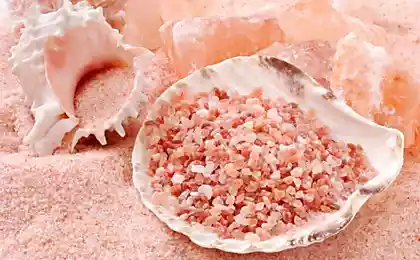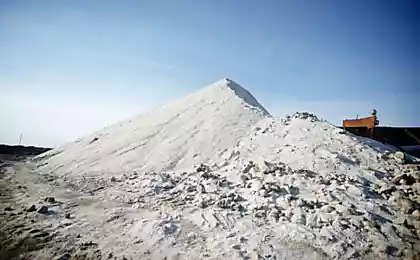510
In the salt...
Often, describing the taste of something, we say — salty. But how to describe the taste of salt? Putting the language crystal of salt, we feel something that could remotely be called bitterness. Salt not much to eat, but if you add it to the dish, then the food will be new dimensions of taste.
Walking on the beach, we can feel it in the air. Accidentally hurt and sliznev a drop of blood, we, too, try it. Salt is the taste of life itself. There are many sayings and omens associated with salt. "Salt history" — meaning, the essence of history itself. To spill salt is bad luck.
With bread and salt greeted the guests since ancient times. And if the bread is a part of life, that guest is offered to share with the owners, salt is something that brightens and fills this life. Feelings, emotions, passion. Things would be different if our life was not salt. But nowadays more often called a salt is "white death".

Is it true? The Northern peoples that do not use salt in food, it is not of cardiovascular diseases. In the 1960-ies Sol announced the culprit of hypertension, renal failure, coronary heart disease, and obesity. To some extent this is true. But do not forget that to exclude salt from your diet — is also very dangerous. So what is the reason and what should we do?
Well-known American expert Paul Bragg believed that the human body has absolutely no need of salt, and called it poison. The fallacy of such views is currently considered to be fully proved.
Let's learn interesting facts about salt.

1. Salt is vital for human life, as well as all other living beings. It is involved in the maintenance and regulation of water-salt balance in the body, sodium-potassium ion exchange.
Thin biological mechanisms maintain a constant concentration of NaCl in the blood and other body fluids. The difference in salt concentration inside the cell and outside is the main mechanism for entry of nutrients to the cell and the output of products of its activity. The same mechanism of separation of salt used in generation and transmission of nerve impulses neurons. In addition, the Cl ion in salt is the main material for the production of hydrochloric acid — an important component of gastric juice
2. On the other hand, death is inevitable and when one-time overeating salt. Lethal dose is 3 grams per 1 kilogram of body weight. For example, for a person weighing 80 kg would be lethal to eat for one meal approximately 240 grams. By the way, is about the amount of salt constantly contains the body of an adult.
3. The average daily intake of salt for an adult: 3-5 grams of salt in cold countries and up to 20 grams in hot. The difference is caused by different intensity of sweating in hot and cold climates.
4. There are many different salts, some of them can also be eaten. But most of all suitable for eating sodium chloride (NaCl), and it taste we call salty. Other salts have undesirable bitter or sour taste, although they too can be of some value in the diet of a person. In the milk mixture for infant food include three salt — magnesium chloride, potassium chloride and sodium chloride.
5. Salt serves as a source of education in the stomach muriatic (hydrochloric) acid, which is a component of gastric juice.
6. At low pH, doctors prescribe the patient a weak aqueous solution of hydrochloric (hydrochloric acid) and at high pH it is experiencing heartburn and it is recommended to take baking soda. It neutralizes the excess acid.
7. Table salt has weak antiseptic properties; 10-15% salt content prevents the development of putrefactive bacteria, which causes its widespread use as a preservative of food.
8. In ancient times salt was extracted by burning some plants in the fire; the formed ash used as a condiment.
9. Ancient peoples valued salt like gold. For example, part of the salary of Roman soldiers (lat. salarium argentum) were given a salt (lat. sal); hence, in particular, happened English. salary ("salary").
10. Already two thousand years BC the Chinese learned how to obtain salt by evaporation of sea water.
11. During the freezing of sea water ice turns out unsalted and not remaining frozen water becomes more salty. Melting ice, you can get fresh water from seawater and brine were used to boil salt with less energy consumption.
12. Pure sodium chloride is non-hygroscopic substance, i.e. it does not absorb moisture. Hygroscopic chlorides of magnesium and calcium. They almost always contain impurities in table salt and because of their presence in salt dampen.
13. The world's largest salt flat is Salar de Uyuni in Bolivia (photo below). Due to the large size, flat surface and high reflectivity in the presence of a thin layer of water, the Uyuni salt flats is the perfect tool for testing and calibration of remote sensing instruments on orbiting satellites.

14. World consumption of salt exceeds 22 million tonnes per year. Each person on average consumes in a year about 8 kg of salt. One third of the produced salt is evaporated from sea water.
15. In stores the salt is up to 97 % of NaCl, and the remaining accounts for various impurities. Often add the iodides and carbonates, in recent years, often add fluoride. Up to 60% of salt sold in Germany and 80% in Switzerland and salt fluorides.
Sometimes table salt is added to other excipients, for example, potassium ferrocyanide (E536 in the European coding system of food additives; non-toxic complex salt) as a flowing agent.
16. Systemic administration of excess compared to normal physiological amounts of salt leads to increased blood pressure. Excessive salt consumption causes heart disease and kidneys.
In the spring of 1648 in Moscow there was the Salt rebellion, caused by the exorbitant tax on salt. Thousands of years ago salt was so expensive that she staged wars. Now salt is the cheapest of all known food additives, except water. published
P. S. And remember, just changing your mind — together we change the world! © Join us at Facebook , Vkontakte, Odnoklassniki
Source: masterok.livejournal.com/2677037.html
Walking on the beach, we can feel it in the air. Accidentally hurt and sliznev a drop of blood, we, too, try it. Salt is the taste of life itself. There are many sayings and omens associated with salt. "Salt history" — meaning, the essence of history itself. To spill salt is bad luck.
With bread and salt greeted the guests since ancient times. And if the bread is a part of life, that guest is offered to share with the owners, salt is something that brightens and fills this life. Feelings, emotions, passion. Things would be different if our life was not salt. But nowadays more often called a salt is "white death".

Is it true? The Northern peoples that do not use salt in food, it is not of cardiovascular diseases. In the 1960-ies Sol announced the culprit of hypertension, renal failure, coronary heart disease, and obesity. To some extent this is true. But do not forget that to exclude salt from your diet — is also very dangerous. So what is the reason and what should we do?
Well-known American expert Paul Bragg believed that the human body has absolutely no need of salt, and called it poison. The fallacy of such views is currently considered to be fully proved.
Let's learn interesting facts about salt.

1. Salt is vital for human life, as well as all other living beings. It is involved in the maintenance and regulation of water-salt balance in the body, sodium-potassium ion exchange.
Thin biological mechanisms maintain a constant concentration of NaCl in the blood and other body fluids. The difference in salt concentration inside the cell and outside is the main mechanism for entry of nutrients to the cell and the output of products of its activity. The same mechanism of separation of salt used in generation and transmission of nerve impulses neurons. In addition, the Cl ion in salt is the main material for the production of hydrochloric acid — an important component of gastric juice
2. On the other hand, death is inevitable and when one-time overeating salt. Lethal dose is 3 grams per 1 kilogram of body weight. For example, for a person weighing 80 kg would be lethal to eat for one meal approximately 240 grams. By the way, is about the amount of salt constantly contains the body of an adult.
3. The average daily intake of salt for an adult: 3-5 grams of salt in cold countries and up to 20 grams in hot. The difference is caused by different intensity of sweating in hot and cold climates.
4. There are many different salts, some of them can also be eaten. But most of all suitable for eating sodium chloride (NaCl), and it taste we call salty. Other salts have undesirable bitter or sour taste, although they too can be of some value in the diet of a person. In the milk mixture for infant food include three salt — magnesium chloride, potassium chloride and sodium chloride.
5. Salt serves as a source of education in the stomach muriatic (hydrochloric) acid, which is a component of gastric juice.
6. At low pH, doctors prescribe the patient a weak aqueous solution of hydrochloric (hydrochloric acid) and at high pH it is experiencing heartburn and it is recommended to take baking soda. It neutralizes the excess acid.
7. Table salt has weak antiseptic properties; 10-15% salt content prevents the development of putrefactive bacteria, which causes its widespread use as a preservative of food.
8. In ancient times salt was extracted by burning some plants in the fire; the formed ash used as a condiment.
9. Ancient peoples valued salt like gold. For example, part of the salary of Roman soldiers (lat. salarium argentum) were given a salt (lat. sal); hence, in particular, happened English. salary ("salary").
10. Already two thousand years BC the Chinese learned how to obtain salt by evaporation of sea water.
11. During the freezing of sea water ice turns out unsalted and not remaining frozen water becomes more salty. Melting ice, you can get fresh water from seawater and brine were used to boil salt with less energy consumption.
12. Pure sodium chloride is non-hygroscopic substance, i.e. it does not absorb moisture. Hygroscopic chlorides of magnesium and calcium. They almost always contain impurities in table salt and because of their presence in salt dampen.
13. The world's largest salt flat is Salar de Uyuni in Bolivia (photo below). Due to the large size, flat surface and high reflectivity in the presence of a thin layer of water, the Uyuni salt flats is the perfect tool for testing and calibration of remote sensing instruments on orbiting satellites.

14. World consumption of salt exceeds 22 million tonnes per year. Each person on average consumes in a year about 8 kg of salt. One third of the produced salt is evaporated from sea water.
15. In stores the salt is up to 97 % of NaCl, and the remaining accounts for various impurities. Often add the iodides and carbonates, in recent years, often add fluoride. Up to 60% of salt sold in Germany and 80% in Switzerland and salt fluorides.
Sometimes table salt is added to other excipients, for example, potassium ferrocyanide (E536 in the European coding system of food additives; non-toxic complex salt) as a flowing agent.
16. Systemic administration of excess compared to normal physiological amounts of salt leads to increased blood pressure. Excessive salt consumption causes heart disease and kidneys.
In the spring of 1648 in Moscow there was the Salt rebellion, caused by the exorbitant tax on salt. Thousands of years ago salt was so expensive that she staged wars. Now salt is the cheapest of all known food additives, except water. published
P. S. And remember, just changing your mind — together we change the world! © Join us at Facebook , Vkontakte, Odnoklassniki
Source: masterok.livejournal.com/2677037.html























